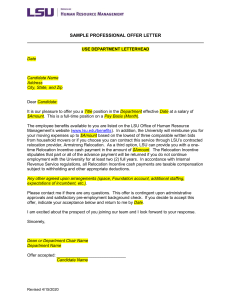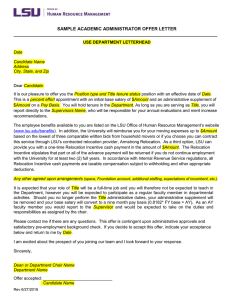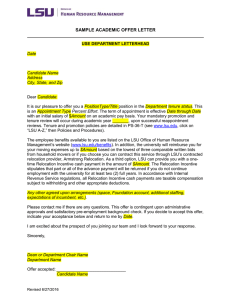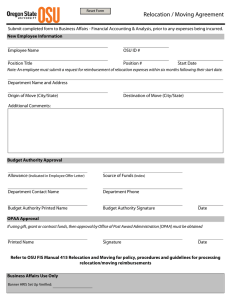Learning from Life Insurance: Lessons for Structuring Insurance for Properties Facing Progressive Climate Risk, Boston College School of Law, November 2015.
advertisement
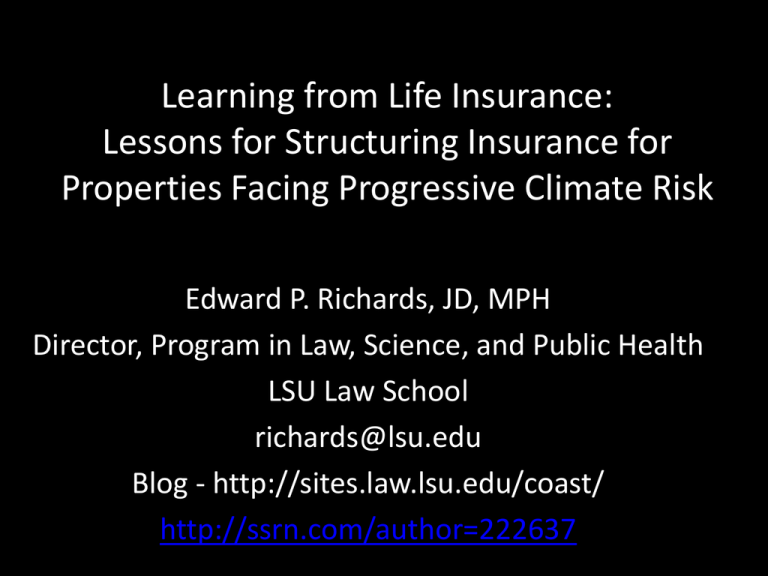
Learning from Life Insurance: Lessons for Structuring Insurance for Properties Facing Progressive Climate Risk Edward P. Richards, JD, MPH Director, Program in Law, Science, and Public Health LSU Law School richards@lsu.edu Blog - http://sites.law.lsu.edu/coast/ http://ssrn.com/author=222637 The Paleoclimate Perspective 2 1,000,000 years of Sea Level • Rohling, EJ, GL Foster, KM Grant, G Marino, AP Roberts, ME Tamisiea, and F Williams. “Sea-Level and Deep-Sea-Temperature Variability over the Past 5.3 Million Years.” Nature, 2014. • 3 When Sea Level is Low, the Delta is Far out in the Gulf at the Continental Shelf Higher Uplands Pleistocene Terrace Pleistocene erosional surface Exposed Shelf BLUM & ROBERTS, 2011 FISK, 1944 4 As Sea Level Rises, the Coast Migrates Inland Higher Uplands Braided stream aggradation Pleistocene Terrace Holocene delta deposits BLUM & ROBERTS, 2011 FISK, 1944 5 The Magic 5,000 Years • . 6 IPCC Sea Level Projections 7 Additional Subsidence Risk for Deltas 500 mm = 20” total relative sea level rise since 1932 subsidence sea level rise 1932 Today 2100 9 Population At Risk • Globally – more than 600,000,000 in the low elevation coastal zone (LECZ) – Many in Asian river delta cities • The United States – South Florida – Atlantic coast – Gulf Coast – Cites on coastal rivers and estuaries 10 Protection in Place • Critical variables – Elevation gradient – Value – Geology • Not feasible in most places for 1 meter+ – New York City is the best case for protection in place 11 Relocation • Most areas will eventually relocate or be destroyed through catastrophic flooding • The idea is orderly relocation • The ideal is politically impossible in the US under current policies 12 The Moral Hazard Problem • Since 1968, the National Flood Insurance Program has subsidized flood insurance for homes under $250 and businesses under $500k. • Disaster relief, such as after Hurricanes Katrina and Sandy, subsidizes communities and those who are under/uninsured. • There is no political will to use the NFIP to force relocation. 13 What Drives the Policy Failure? • Property rights expectations evolved for a steady state world. • As long as there is an expectation that property is eternal, then policy will follow. – “Buy land, they are not making any more.” 14 The Life Insurance Model • Everyone dies. • The insurance bet is when. • The policy structure is a predictable increase in rates as the individual ages. • The expectation is that at some given age, the cost of the insurance will exceed its value, if the insured is still alive. • Individualized rating factors can be added. 15 Applied to Coastal Property • Flood insurance underwriting would include a projected schedule for premium increases as sea level rises. • This would effectively create a life span for property. • Like human life expectancy, it would not be certain because of the uncertainty of sea level rise and property value fluctuations. 16 Effects of a Property Lifetime • Rethinking long term financing such as 30 year mortgages. • Buyout cost for relocation goes down with time. • Encourages more realistic risk assessment. • Puts a ceiling on the value of reconstruction after disasters. • Makes paid relocation more palatable. 17 Could this be Implemented? • No, if the failure of NFIP reform in an indication. • Yes, for large commercial property interests. – No subsidy – Reinsurers will eventually price them off the coast. – Insurance regulators could require a projection of future rates based on sea level rise. • Seeing the impact on business could change the politics for homeowners. 18
